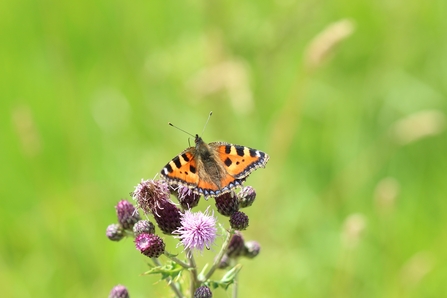
Small tortoiseshell © Agatha Thompson
A former arable field at Wilder Nunwell, slowly transforming into a mosaic of habitats © Agatha Thompson

Small tortoiseshell © Agatha Thompson
After taking on Wilder Little Duxmore in 2020, the site is now nearly four years into being rewilded. We’ve recorded some fantastic results to date, with species diversity increasing, soil condition improving and habitats diversifying. The field edges are quickly scrubbing up, a process that happens relatively rapidly on the Isle of Wight due to the lack of deer pressure.
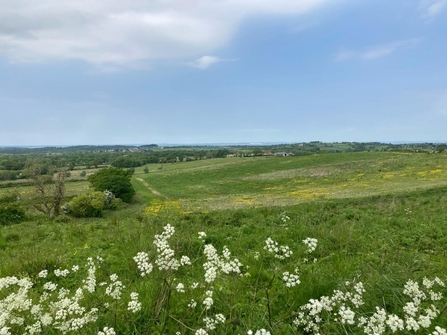
Wilder Little Duxmore © Agatha Thompson
Below are fixed point photography images from 2021 and 2023 showing the extent of scrub increase at Wilder Little Duxmore.
One of the main aims of rewilding is to create diverse and varied habitats which can support a wide range of species. The higher the species diversity, the more species are present to carry out a wide variety of ecological processes and the more complete an ecosystem will be. Good ecosystem function leads to more resilient habitats, meaning they are less vulnerable to challenges such as climate change.
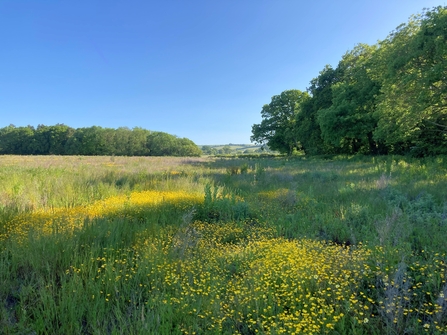
A former arable field at Wilder Nunwell, slowly transforming into a mosaic of habitats © Agatha Thompson
One of the ways we monitor rewilding progress is to survey bioindicators. These are groups of wildlife which are particularly vulnerable to changes in their environment and are therefore quick to show changes in their numbers, diversity, composition and behaviour. They also provide indications of how other more cryptic species might be faring; if your site is able to support a wide range of bioindicators, it is likely to be supporting other more complex species which are harder to survey.
At our rewilding sites we survey a range of bioindicators, including: birds, bats, pollinators, earthworms and dung beetles.
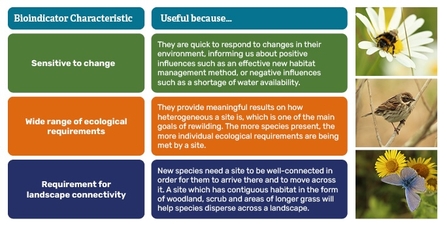
Whilst birds and butterflies are fantastic bioindicators, we must also think about the less visible wildlife which underpins ecosystem function. Earthworms are found everywhere: in gardens, local parks and nature reserves, and are an essential component of healthy soils. They are known as “ecosystem engineers” because they carry out a number of different processes which improve soil condition. These include breaking down organic matter, increasing drainage by creating burrows, improving soil structure and of course providing a vital food source for many other species.
At Wilder Little Duxmore we’ve now been carrying out ecological monitoring for three years, and have seen the site becoming wilder and more variable in habitat over time. As a result, we have recorded 14 new bird species on the breeding bird surveys since the baseline survey in 2021 and 46 bird species in total. We have also recorded 8 new butterfly species since 2021, making a total of 26 on the site. Amongst these, we have recorded two species listed as Endangered on the Butterfly Red List: Glanville fritillary and wall brown, and two species listed as Vulnerable: chalkhill blue and small heath.
We’ve also seen some significant changes in the previously agricultural soils at Wilder Little Duxmore, with the soil mineral nitrogen level decreasing by 47% in just two years. A decrease in phosphorus levels has also been recorded, to the point where it is no longer considered a limiting factor for grassland restoration in two fields where it was previously. We hope that over time, the soil condition and suitability for restoration will continue to improve at Wilder Little Duxmore, leading to the establishment of species rich grassland and the return of even more species.
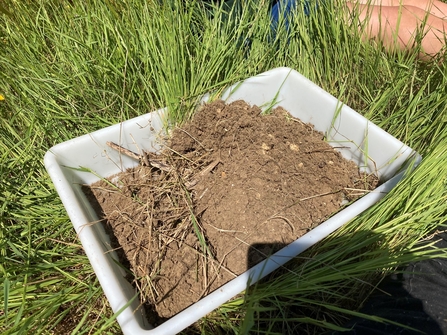
Soil tray © Agatha Thomspson
At Wilder Nunwell we’ve completed two years’ worth of surveys, and have already had some promising results from the bioindicator surveys. We recorded 10 new species on the breeding bird surveys last year, making the total bird species count an impressive 67 species.
In a couple of months we will be carrying out the second round of soil analysis surveys at Wilder Nunwell, two years after the baseline analysis. We are hoping to see some similar results to those recorded at Wilder Little Duxmore, with nutrient loads decreasing and improved soil structure.
Both sites are being carefully grazed by a combination of livestock, including cattle, ponies and pigs. This conservation grazing regime is generating a more varied vegetation structure, leading to the creation of microhabitats and increased suitability for groups such as reptiles and crickets. Over time, the selective grazing preferences of these livestock will lead to a reduction in strong, ruderal species, and open up opportunities for wildflowers to colonise. The pigs create areas of natural disturbance to the ground, leaving wallows in their wake and mimicking the role of native wild boar.
Both sites are grazed by Belted Galloway cattle and native breed pigs in partnership with Nunwell Home Farm
The visual changes at Wilder Nunwell are really striking, with many fields transitioning from monocultural, luminous green landscapes, to being colonised by tougher ruderal species with increased flora cover. The images below show one of the fields at Nunwell just one year apart:
Wilder Nunwell provides us with a blank canvas, upon which we can clearly envisage its wild future: a complex jigsaw landscape of interlinked habitats, with grassland teeming with invertebrates and wetland areas providing food and shelter for a myriad of bird species, all interlinked by scrub and woodland which provide wildlife corridors, connecting Nunwell to the wider landscape. It represents a huge stepping stone in the Trust’s vision for a “Wilder Wight”, as well as our goal to see 30% of land and sea connected and protected for nature’s recovery by 2030.
Hampshire & Isle of Wight Rewilding Network
Another step towards our 30 by 30 goal is the creation of the Hampshire & Isle of Wight Rewilding Network. The aim of the network is to bring landowners across the two counties together to build up momentum for rewilding and ecological restoration. It provides a platform for experienced rewilders to share their knowledge and skills with those at the beginning of their rewilding journey, and to inspire members to work together towards the goal of increasing land available for nature’s recovery.
We launched the network back in April 2023 at our own rewilding sites on the Island, and saw 50 landowners and colleagues from partner organisations come together to support the network. We held a second event in October at a private rewilding site, giving network members the opportunity to see what can be achieved through just 10 years of rewilding.
Our third event will be held at Ewhurst Park in April and will be targeted at private landowners. One of the main themes of the day will be how restoring land for nature can go hand in hand with food production. The event will provide a platform for these important discussions and will hopefully inspire landowners with ways to support nature on their estates through rewilding and restoration.
The network’s first steps are being supported by a grant from Rewilding Britain’s Innovation Fund, allowing us to put in the hard work needed to bring rewilders together and build up momentum for nature restoration in Hampshire and on the Isle of Wight. We are grateful to Rewilding Britain for their support, and are looking forward to continuing to work with the team as the network develops.
Please sign up to the network here if you are interested, or contact Agatha Thompson if you have any questions.